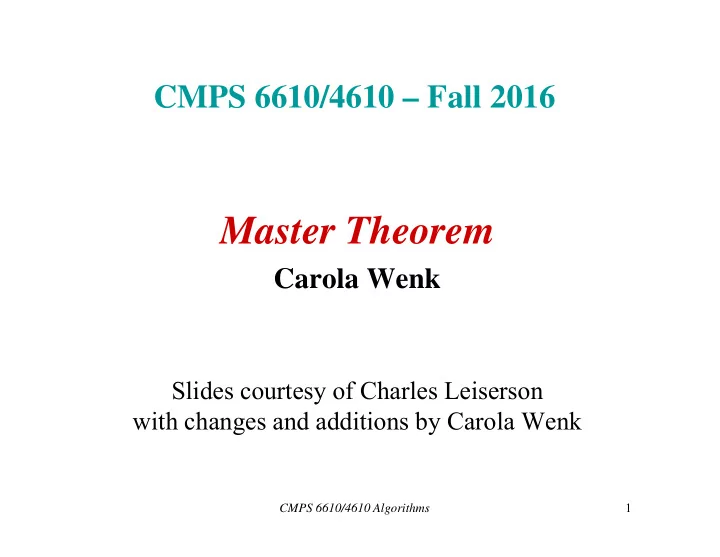

CMPS 6610/4610 – Fall 2016 Master Theorem Carola Wenk Slides courtesy of Charles Leiserson with changes and additions by Carola Wenk 1 CMPS 6610/4610 Algorithms
The divide-and-conquer design paradigm 1. Divide the problem (instance) into subproblems of sizes that are fractions of the original problem size. 2. Conquer the subproblems by solving them recursively. 3. Combine subproblem solutions. Runtime recurrences 2 CMPS 6610/4610 Algorithms
The master method The master method applies to recurrences of the form T ( n ) = aT ( n / b ) + f ( n ) , where a 1, b > 1, and f is asymptotically positive. 3 CMPS 6610/4610 Algorithms
Example: merge sort 1. Divide: Trivial. 2. Conquer: Recursively sort a =2 subarrays of size n /2= n / b 3. Combine: Linear-time merge, runtime f ( n ) O ( n ) T ( n ) = 2 T ( n /2) + O ( n ) subproblem size work dividing # subproblems and combining T ( n ) = aT ( n / b ) + f(n) 4 CMPS 6610/4610 Algorithms
Master Theorem T ( n ) = aT ( n / b ) + f ( n ) CASE 1 : T ( n ) = ( n log ba ) f ( n ) = O ( n log ba – ) for some >0 CASE 2 : f ( n ) = ( n log ba log k n ) T ( n ) = ( n log ba log k +1 n ) for some k ≥ 0 CASE 3 : (i) f ( n ) = ( n log ba + ) T ( n ) = ( f ( n )) for some >0 and (ii) a f ( n/b ) c f ( n ) for some c < 1 5 CMPS 6610/4610 Algorithms
How to apply the theorem Compare f ( n ) with n log ba : 1. f ( n ) = O ( n log ba – ) for some constant > 0. • f ( n ) grows polynomially slower than n log ba (by an n factor). Solution: T ( n ) = ( n log ba ) . 2. f ( n ) = ( n log ba log k n ) for some constant k 0. • f ( n ) and n log ba grow at similar rates. Solution: T ( n ) = ( n log ba log k +1 n ) . 6 CMPS 6610/4610 Algorithms
How to apply the theorem Compare f ( n ) with n log ba : 3. f ( n ) = ( n log ba + ) for some constant > 0. • f ( n ) grows polynomially faster than n log ba (by an n factor), and f ( n ) satisfies the regularity condition that af ( n/b ) c f ( n ) for some constant c < 1. Solution: T ( n ) = ( f ( n )) . 7 CMPS 6610/4610 Algorithms
Example: merge sort 1. Divide: Trivial. 2. Conquer: Recursively sort 2 subarrays. 3. Combine: Linear-time merge. T ( n ) = 2 T ( n /2) + O ( n ) work dividing # subproblems subproblem size and combining n log ba = n log 2 2 = n 1 = n C ASE 2 ( k = 0) T ( n ) = ( n log n ) . 8 CMPS 6610/4610 Algorithms
Example: binary search T ( n ) = 1 T ( n /2) + (1) work dividing # subproblems and combining subproblem size n log ba = n log 2 1 = n 0 = 1 C ASE 2 ( k = 0) T ( n ) = (log n ) . 9 CMPS 6610/4610 Algorithms
Master theorem: Examples Ex. T ( n ) = 4 T ( n /2) + a = 4, b = 2 n log ba = n 2 ; f ( n ) = . C ASE 1 : f ( n ) = O ( n 2 – ) for = 1.5. T ( n ) = ( n 2 ). Ex. T ( n ) = 4 T ( n /2) + n 2 a = 4, b = 2 n log ba = n 2 ; f ( n ) = n 2 . C ASE 2 : f ( n ) = ( n 2 log 0 n ), that is, k = 0. T ( n ) = ( n 2 log n ). 10 CMPS 6610/4610 Algorithms
Master theorem: Examples Ex. T ( n ) = 4 T ( n /2) + n 3 a = 4, b = 2 n log ba = n 2 ; f ( n ) = n 3 . C ASE 3 : f ( n ) = ( n 2 + ) for = 1 and 4( n /2) 3 cn 3 (reg. cond.) for c = 1/2. T ( n ) = ( n 3 ). Ex. T ( n ) = 4 T ( n /2) + n 2 /log n a = 4, b = 2 n log ba = n 2 ; f ( n ) = n 2 /log n. Master method does not apply. In particular, for every constant > 0, we have log n o ( n ). 11 CMPS 6610/4610 Algorithms
Conclusion • Divide and conquer is just one of several powerful techniques for algorithm design. • Divide-and-conquer algorithms can be analyzed using recurrences and the master method . • Can lead to more efficient algorithms 12 CMPS 6610/4610 Algorithms
Recommend
More recommend